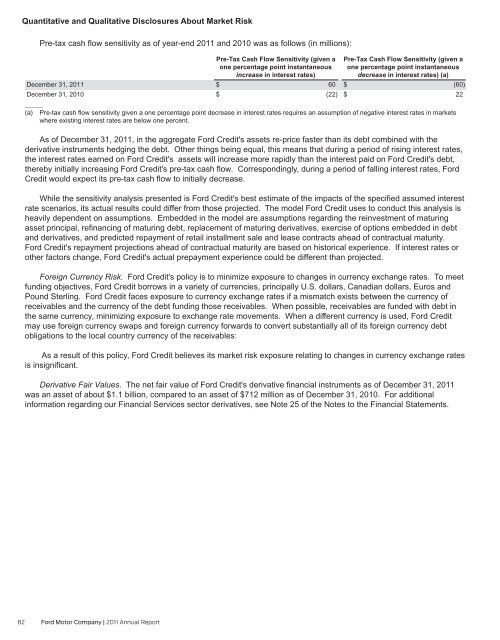PROFITABLE GROWTH FOR ALL
Create successful ePaper yourself
Turn your PDF publications into a flip-book with our unique Google optimized e-Paper software.
Quantitative and Qualitative Disclosures About Market Risk<br />
Pre-tax cash flow sensitivity as of year-end 2011 and 2010 was as follows (in millions):<br />
Pre-Tax Cash Flow Sensitivity (given a<br />
one percentage point instantaneous<br />
increase in interest rates)<br />
Pre-Tax Cash Flow Sensitivity (given a<br />
one percentage point instantaneous<br />
decrease in interest rates) (a)<br />
December 31, 2011<br />
December 31, 2010<br />
$<br />
$<br />
60<br />
(22)<br />
$<br />
$<br />
(60)<br />
22<br />
_____<br />
(a) Pre-tax cash flow sensitivity given a one percentage point decrease in interest rates requires an assumption of negative interest rates in markets<br />
where existing interest rates are below one percent.<br />
As of December 31, 2011, in the aggregate Ford Credit's assets re-price faster than its debt combined with the<br />
derivative instruments hedging the debt. Other things being equal, this means that during a period of rising interest rates,<br />
the interest rates earned on Ford Credit's assets will increase more rapidly than the interest paid on Ford Credit's debt,<br />
thereby initially increasing Ford Credit's pre-tax cash flow. Correspondingly, during a period of falling interest rates, Ford<br />
Credit would expect its pre-tax cash flow to initially decrease.<br />
While the sensitivity analysis presented is Ford Credit's best estimate of the impacts of the specified assumed interest<br />
rate scenarios, its actual results could differ from those projected. The model Ford Credit uses to conduct this analysis is<br />
heavily dependent on assumptions. Embedded in the model are assumptions regarding the reinvestment of maturing<br />
asset principal, refinancing of maturing debt, replacement of maturing derivatives, exercise of options embedded in debt<br />
and derivatives, and predicted repayment of retail installment sale and lease contracts ahead of contractual maturity.<br />
Ford Credit's repayment projections ahead of contractual maturity are based on historical experience. If interest rates or<br />
other factors change, Ford Credit's actual prepayment experience could be different than projected.<br />
Foreign Currency Risk. Ford Credit's policy is to minimize exposure to changes in currency exchange rates. To meet<br />
funding objectives, Ford Credit borrows in a variety of currencies, principally U.S. dollars, Canadian dollars, Euros and<br />
Pound Sterling. Ford Credit faces exposure to currency exchange rates if a mismatch exists between the currency of<br />
receivables and the currency of the debt funding those receivables. When possible, receivables are funded with debt in<br />
the same currency, minimizing exposure to exchange rate movements. When a different currency is used, Ford Credit<br />
may use foreign currency swaps and foreign currency forwards to convert substantially all of its foreign currency debt<br />
obligations to the local country currency of the receivables:<br />
As a result of this policy, Ford Credit believes its market risk exposure relating to changes in currency exchange rates<br />
is insignificant.<br />
Derivative Fair Values. The net fair value of Ford Credit's derivative financial instruments as of December 31, 2011<br />
was an asset of about $1.1 billion, compared to an asset of $712 million as of December 31, 2010. For additional<br />
information regarding our Financial Services sector derivatives, see Note 25 of the Notes to the Financial Statements.<br />
82 Ford Motor Company | 2011 Annual Report


